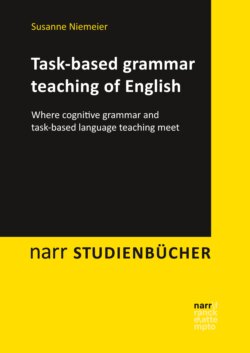Читать книгу Task-based grammar teaching of English - Susanne Niemeier - Страница 25
На сайте Литреса книга снята с продажи.
3.1.4 Usage-based perspective
ОглавлениеA further premise in cognitive linguistic theory is the notion that language is “usage-based”, which refers to a descriptive view of language and does away with the prescriptive view that the generativists still maintained (‘ideal speaker’). Although other linguistic as well as didactic paradigms call themselves “usage-based” as well, cognitive linguistics is presumably the most prominent example (cf. TYLER 2010). N. ELLIS/WULFF see two working hypotheses as a common denominator of all usage-based approaches to second language learning, namely that
(1) language learning is primarily based on learners’ exposure to their second language (L2) in use, that is, the linguistic input they receive [and] (2) learners induce the rules of their L2 from the input by employing cognitive mechanisms that are not exclusive to language learning, but that are general cognitive mechanisms at work in any kind of learning, including language learning. (N. ELLIS/WULFF 2013: 75)
As a consequence, a usage-based model of language does not aim at representing a linguistic system controlled by rigid rules but rather wants to “depict the complexity of language use” (TOMASELLO 2003: 5). In other words: cognitive linguistics aims at studying and representing language as it occurs in real life, as opposed to the abstract and context-free representations favoured by the generativists and also favoured by traditional textbooks and grammar exercises. A rule can never be a substitute for actually occurring instances of the construction in question. For the generativists, language use was relatively unimportant, as they were more interested in language structure. Cognitive linguistics has turned this view around, because it “considers the knowledge of language to be experientially based in actual speech” (GEERAERTS 2006:6), as words and grammar patterns do not occur on their own but are always part of actual utterances, actual conversations and actual speaker intentions.
Encompassing the complete lexis-grammar continuum, expressions and grammatical constructions are categorised by the language users according to their degree of abstractness and to the phonological, semantic and pragmatic associations between the linguistic units involved (cf. BYBEE 2008). These associations include information about form, meaning and the context of use, for words as well as for grammatical constructions. If words and constructions are used frequently, in so-called ‘usage events’1, the connections between them get strengthened (cf. ibid.: 216). LANGACKER (2008: 81), for example, recommends “providing the learners with sufficient exposure of representative uses of a given unit. Ideally, moreover, this exposure should occur in the context of meaningful exchanges approximating socially and culturally normal usage events”. Such exposure is meant to empower the learners and to give them the confidence to act native-speaker-like whenever they find themselves in situations that resemble the usage events they were exposed to in the foreign language classroom. This rationale is followed in all of the more practical teaching suggestions in the second part of this book.
